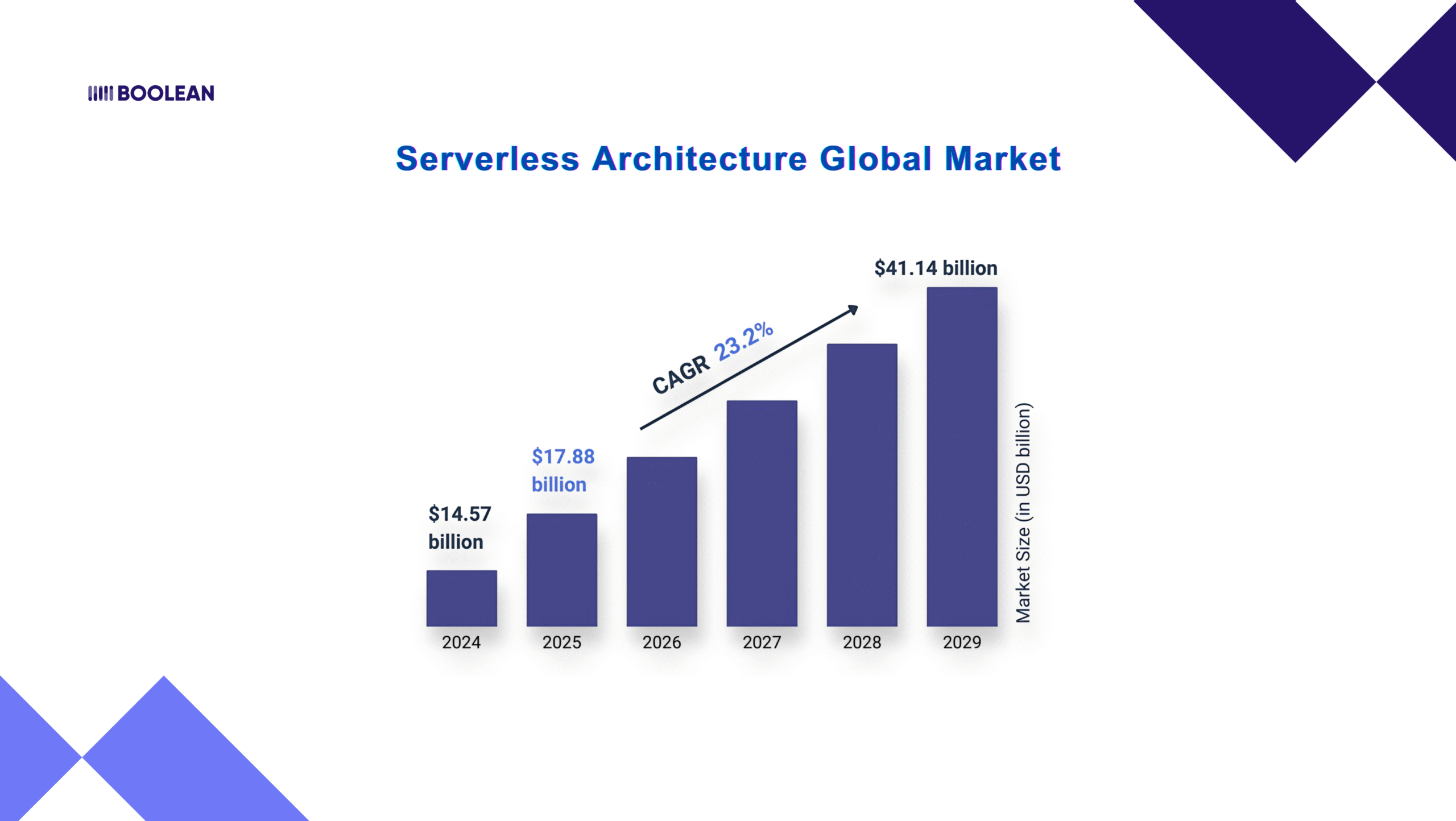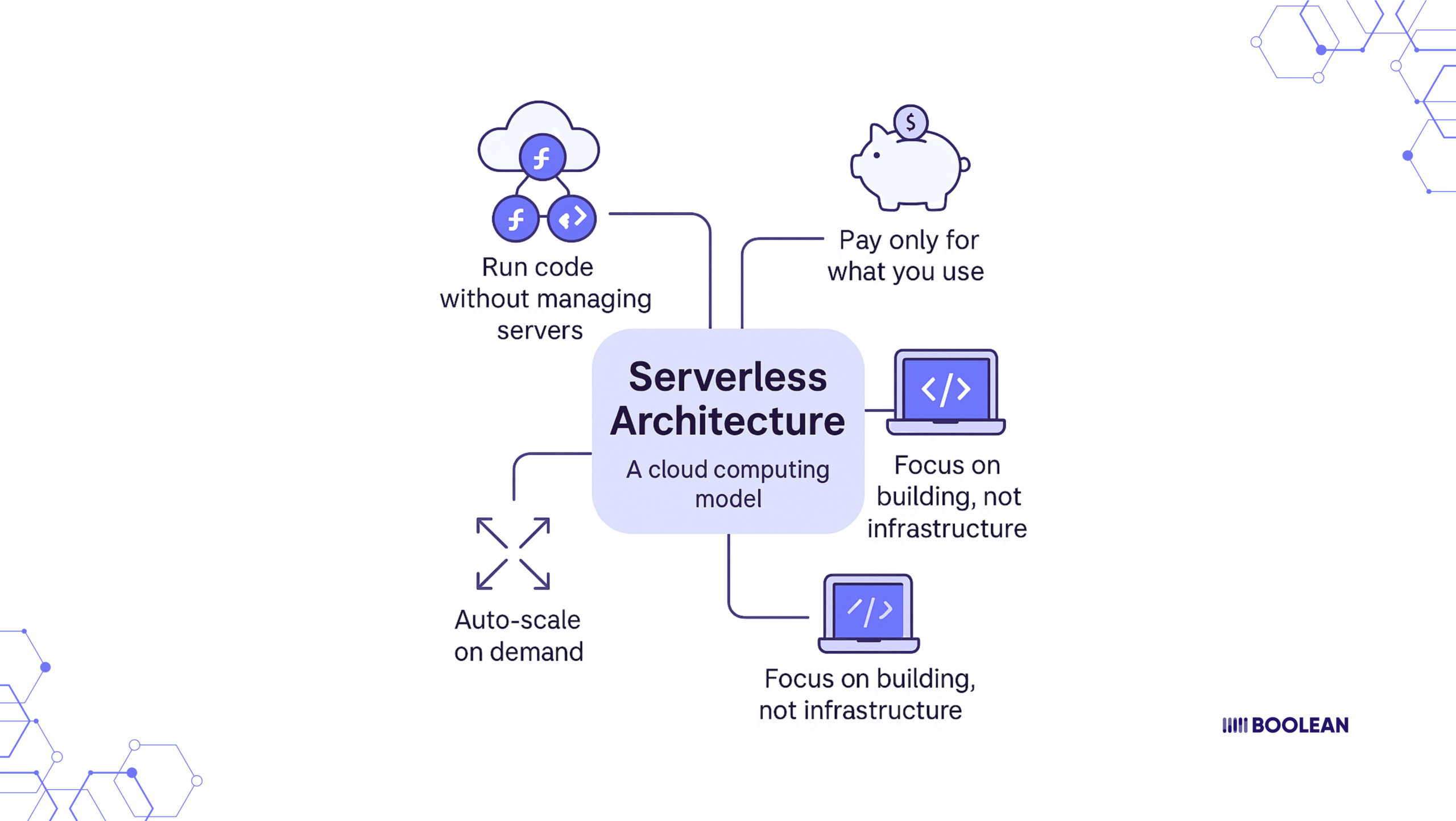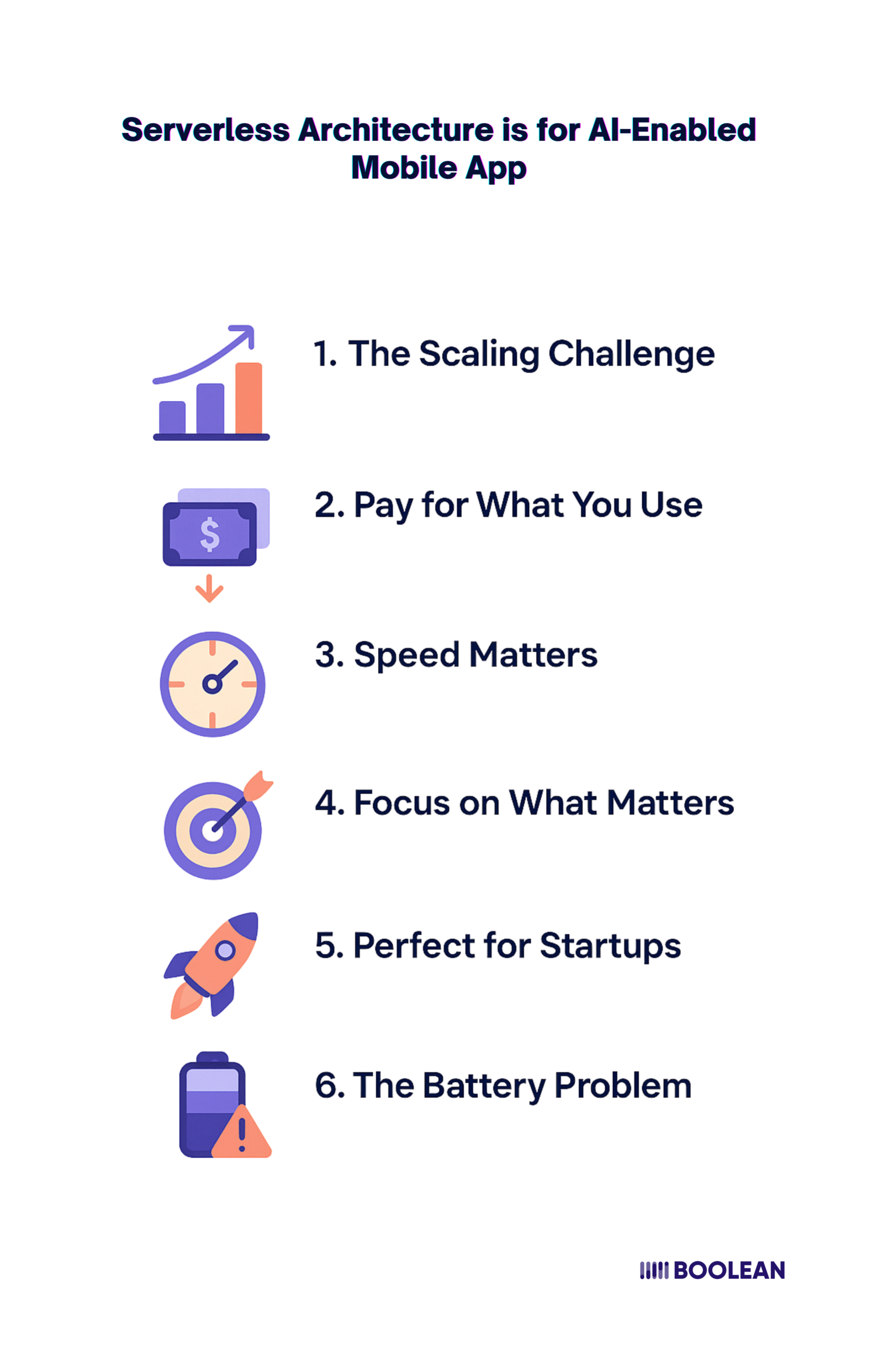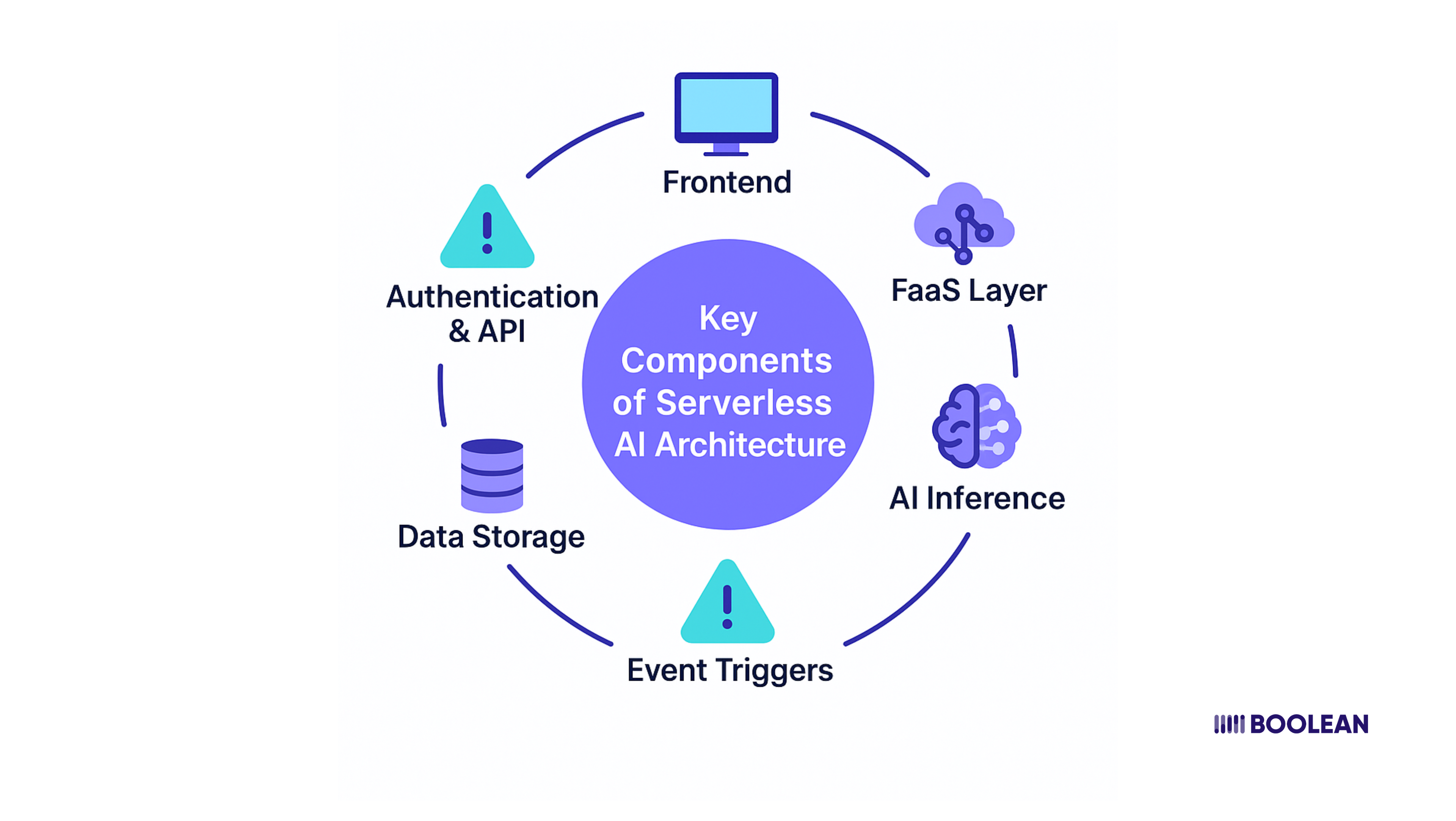Introduction
Ever feel devastated by the idea of managing the server while trying to create an AI-enabled mobile app?
You are not alone.
Here’s the thing: building mobile apps with AI features used to be a nightmare. You needed expensive servers and complex infrastructure. A team of specialists is just to keep things running.
And don’t even get me started on the costs when your app suddenly went viral.
But something changed.
The serverless architecture market tells the story. It’s exploding. From $14.57 billion in 2024 to $17.88 billion in 2025.

By 2029? We’re looking at $41.14 billion. That’s a 23.2% growth rate year after year.
Why this massive growth? Because developers discovered something game-changing.
The server-free architecture came together and flipped the script.
Now, you can create a refined AI-powered mobile app without touching a single server.
No other at 3 o’clock wake-up calls because your server crashed.
No more payment for passive computing power.
Think about the apps you use daily. That photo editor that removes backgrounds instantly? The fitness app that counts your reps? The language learning app that corrects your pronunciation?
They’re all using AI. And many of them run on serverless architecture. The combination just makes sense.
AI workloads are unpredictable. One moment, your app is processing a single image. Next, thousands of users are hitting your AI features simultaneously. Serverless handles this beautifully. It scales up when you need it. Scales down when you don’t. You only pay for what you use.
This guide will show you exactly how to harness this powerful combination.
Whether you are eager about a mobile developer AI or AI enthusiasts wishing to create a mobile app, you are in the right place. We will break the complex accessories into cutting pieces.
Ready to join the revolution that shapes mobile app development again? Let’s dive in.
What is Serverless Architecture?

Let’s be clear on something. “Serverless” does not mean that there are no servers.
The servers are still present. You don’t have to worry about them right now. It is like ordering food instead of cooking. The kitchen is still present. You don’t just need to manage it.
So, what is actually a serverless architecture?
Think of it this way.
- Traditional hosting is like the owner of a car. You pay for it whether you drive it or not. You handle maintenance. Insurance. Parking. Everything.
- Serverless is like calling an Uber. You pay only for the ride. Someone else handles the rest.
Here’s what makes serverless special:
Your code runs in small chunks, which are called functions.
Each function performs a specific work. Process an image. Send a notification. Validate user input. When someone uses your app, these functions spring to life. When they’re done, they disappear. You’re only charged for those milliseconds of action.
Very clean, isn’t it?
Servers have two main types: FaaS and BaaS. Do not let the anonymity scare you.
- Functions as a Service (FaaS) is a platform where you write small pieces of code that run when they are triggered. User uploads a photo? Function runs. Processes the image. Done. Think of them as tiny specialized workers that appear when needed.
- Backend as a Service (BaaS) gives you ready-made backend features. Authentication. Databases. File storage. Push notifications. It’s like having a pre-built foundation for your house. You just add the walls and roof.
Now, who provides these serverless services?
The big three dominate the space. AWS Lambda leads the pack. It’s powerful, flexible, and integrates with everything Amazon offers.
Google Cloud functions shine with its AI and machine learning tools. Perfect for our AI-enabled mobile apps.
Azure Functions plays nicely with Microsoft’s ecosystem and offers great developer tools.
But here’s what beginners often miss.
Serverless is not only about saving money or avoiding server management. This originally changes how you think about the creation of apps.
Instead of planning for peak capacity, you build for actual usage. Instead of monolithic applications, you create modular functions.
Remember when I mentioned that massive market growth? This is why. Developers realized they could build better apps faster. Startups could compete with big companies. A single developer could handle workloads that used to require entire teams.
The best part? Getting started is surprisingly simple. Most providers offer generous free tiers. You can experiment without spending a dime.
Why Serverless AI Architecture in Mobile Apps?
Here’s a question that might keep you up at night: How do you build an AI-powered mobile app that doesn’t drain your users’ batteries or your bank account?
The answer lies in combining serverless architecture with AI. And once you see why, you’ll wonder why anyone does it differently.
Let’s start with the basics.
AI is hungry. Hungry for processing power. Hungry for memory. Hungry for energy. Running complex AI models directly on mobile devices? That’s a recipe for frustrated users with dead phones. But sending everything to traditional servers? That’s expensive and complicated.
Serverless changes the game entirely.
Picture this scenario. Your photo editing app has 10,000 users. On average, each user applies AI filters to five photos daily.
But here’s the catch: they all do it at different times. Some at breakfast. Others during lunch breaks. Many late at night.
With traditional servers, you’d need to maintain enough capacity for peak usage. That means paying for powerful servers 24/7, even when they’re sitting idle at 3 AM.
With serverless? You pay only for those exact moments when users apply filters. Five photos. Five function executions. Five small charges. That’s it.
But cost is just the beginning.
Think about scaling. Your app goes viral on apps like TikTok. Suddenly, instead of 10,000 users, you have 100,000. With traditional architecture, your servers crash. Users get error messages. One-star reviews flood in.
Serverless doesn’t blink. It scales automatically. 10 users or 10 million, it handles them all. No configuration needed. No emergency server provisioning. It just works.
Here’s what makes this combination particularly powerful for mobile apps:
Mobile users are impatient. They want results now. Serverless providers have data centers worldwide. Your AI functions run close to your users. Low latency. Fast responses. Happy users.
Battery life matters too. Instead of running AI models on the device, you offload the heavy lifting to the cloud. The phone just sends data and receives results. Users get powerful AI features without watching their battery percentage plummet.
Let me share a real example.
A language learning app I worked with needed speech recognition. Running the AI model on phones was impossible, too large, too slow.
Traditional servers were too expensive for a startup. They went serverless. Now they process millions of voice samples monthly.
Their AWS bill? Less than what they used to pay for a single server.
The technical benefits stack up quickly:
No infrastructure management means developers focus on features, not servers.
But here’s the real magic.
Serverless lets you experiment fearlessly. Want to try a new AI model? Deploy it to a small percentage of users. See how it performs. Scale up if it works. Roll back if it doesn’t. No risk. No massive infrastructure changes.
This flexibility is crucial for AI enabled mobile apps. AI technology evolves rapidly. New models appear monthly. Serverless architecture lets you adapt quickly. Stay competitive. Delight users with cutting-edge features.
Remember those market growth numbers from earlier? This is why developers are flocking to serverless. It solves real problems. It makes the impossible possible.
And for beginners? It levels the playing field. You don’t need a DevOps team. You don’t need deep pockets. You just need good ideas and the willingness to learn.
Why Serverless Architecture is Perfect for AI-Enabled Mobile Apps

Wondering how to build smarter mobile apps without the infrastructure headaches? Let’s explore why serverless and AI work so well together.
- The Scaling Challenge
AI workloads are wildly unpredictable. Your meditation app might process 100 voice sessions at 6 AM and 10,000 at lunch break. Traditional servers would either crash or cost a fortune.
Serverless? It doesn’t care. It scales instantly. Automatically. No configuration needed.
- Pay for What You Use
Here’s what kills most AI app ideas: server costs. Running AI models 24/7 gets expensive fast. Even when no one’s using them.
With serverless, you pay per execution. User analyze one photo? You pay for one execution. Simple. Fair. Sustainable.
- Speed Matters
Mobile users are impatient. They won’t wait 30 seconds for AI results.
Serverless providers have global networks. Your AI functions run near your users. Millisecond responses. Happy users. Better reviews.
- Focus on What Matters
You’re building an AI app, not managing servers. Serverless handles the infrastructure headaches. Security patches. Load balancing. Scaling. All automatic.
You write code. Deploy. Done.
- Perfect for Startups
No upfront costs. No minimum fees. Start small. Grow gradually. Your infrastructure bill grows with your success, not before it.
- The Battery Problem
Running AI models on phones drains batteries fast. Users hate that. Serverless lets you offload heavy processing to the cloud. Phones stay cool. Batteries last longer.
The bottom line? Serverless removes every traditional barrier to building AI enabled mobile apps. It’s not just better. It’s the only approach that makes sense for most developers today.
Key Components of Serverless AI Architecture

The construction of a Serverless AI mobile app is like assembling Lego blocks. Each piece has a specific purpose. Let’s break what you want.
- Frontend
This is what users see and touch. Your beautiful interface.
React Native lets you build for iOS and Android with a codebase. JavaScript developers love it. Flutter offers stunning UI with Google’s backing. Swift and Kotlin give you native power for iOS and Android, respectively.
Pick what you know. They all work great with serverless backends.
- FaaS Layer
This is where the magic happens. Your functions live here.
AWS Lambda is the veteran. Reliable. Well-documented. Integrates with everything. Google Cloud Functions shines with AI workloads. Built-in machine learning tools. Azure Functions plays nicely with enterprise systems.
Think of these as your app’s brain cells. Each function does one thing well. Process an image. Analyze text. Generate recommendations.
You do not need to make AI models from scratch. It is like strengthening the wheel.
OpenAI gives you GPT for text and DALL-E for images.
Replicate hosts thousands of open-source models. One API for everything.
Hugging Face is the GitHub of AI models. Community-driven. Cutting-edge.
These services handle the heavy AI lifting. You just send requests and get results.
- Data Storage
Your app needs a home for user data, processed results, and media files.
Firebase is the Swiss Army Knife. Real-time database. File storage. User analytics. All in one.
Supabase is the open-source alternative.
PostgreSQL powers with real-time features. S3 handles large files like a champ. Images. Videos. AI model outputs. Firestore excels at structured data. User profiles. App settings. AI results.
Mix and match based on your needs.
- Event Triggers
Your app needs to respond to events. User actions. Scheduled tasks. External webhooks.
Webhooks let external services talk to your app. Payment confirmed? Trigger a function. Push notifications keep users engaged.
AI task complete? Notify them instantly. Message queues handle heavy workloads. Process 1000 images? Queue them up. No crashes.
These are your app’s nervous system. They make everything reactive and responsive.
- Authentication & API Gateway
Security isn’t optional. You need to know who’s using your app and protect your endpoints.
AWS Cognito handles user management like a pro. Sign-up. Login. Password resets. Social logins.
Auth0 is the developer favorite. Beautiful UI components. Enterprise features. Firebase Auth integrates seamlessly with other Firebase services. Simple setup.
Your API Gateway sits in front of everything. It’s the bouncer at the club. Checks credentials. Rate limit requests. Routes traffic to the right functions.
Choosing Your Stack
Feeling overwhelmed? Start simple.
- For beginners: Firebase + Google Cloud Functions + OpenAI API. Everything’s integrated. Great documentation. Generous free tiers.
- For React Native developers: AWS Amplify gives you the entire stack. Pre-configured. Ready to go.
- For enterprises: Azure Functions + Cognitive Services. Compliance features. Enterprise support.
The best part? You can switch components later. Not married to any choice. That’s the power of serverless architecture.
Step-by-Step Guide: Building Your First Serverless AI Mobile App
Ready to build something real? Let’s create a simple AI-powered mobile app that removes backgrounds from photos. No fluff. Just practical steps.
What We’re Building Today
We’ll create a simple photo classification app. Users take a picture, and our AI tells them what’s in it. Think of it as a “smart camera” that can identify objects, animals, or scenes.
Why this project? It’s practical, visual, and touches all the key concepts you need to understand.
Before diving into code, let’s understand what we’re creating:
- Mobile App: Takes photos and sends them to the cloud
- Serverless Function: Receives the photo and processes it
- AI Service: Analyzes the photo and returns results
- Database: Stores results for future reference
Simple, right? Now let’s build it.
Step 1: Setting Up Your Foundation
Choose Your Mobile Platform
Start with what you know. If you’re comfortable with React, go with React Native. Love Swift? Stick with iOS native. Already know Flutter? Perfect.
The beauty of serverless architecture is that your mobile choice doesn’t limit your backend options.
Pick Your Cloud Provider
For beginners, I recommend starting with one of these:
AWS – Most comprehensive, steepest learning curve
Google Cloud – Great AI services, moderate complexity
Vercel – Simplest to start, limited AI options
For this guide, we’ll use AWS. It has the most resources and community support.
Create Your Accounts
You’ll need:
- AWS account (free tier available)
- Mobile development environment
- Code editor (VS Code works great)
Don’t worry about costs yet. We’ll stay within free limits.
Step 2: Building Your Serverless Backend
Understanding AWS Lambda
Think of Lambda as a magical computer that only runs when needed. No servers to manage. No uptime worries. You write code, upload it, and AWS handles everything else.
It’s like having a personal assistant who only gets paid when they’re actually working.
Creating Your First Function
Log in to AWS Console. Navigate to Lambda. Click “Create Function.”
Choose “Author from scratch.” Name it something simple like photo-classifier. Pick Python 3.9 as your runtime.
Here’s your first function:
import json
import boto3
def lambda_handler(event, context):
# This is where the magic happens
print(“Photo received for classification”)
return {
‘statusCode’: 200,
‘body’: json.dumps(‘Hello from your AI function!’)
}
Hit “Deploy.” Congratulations! You just created your first serverless function.
Testing Your Function
Click the “Test” button. Create a new test event. Run it.
See that “Hello from your AI function!” message? That’s your code running in the cloud. No server setup required.
Step 3: Adding AI Vision Capabilities
Integrating Amazon Rekognition
Rekognition is AWS’s computer vision service. It can identify thousands of objects, scenes, and concepts in images.
Update your function:
import json
import boto3
import base64
def lambda_handler(event, context):
rekognition = boto3.client(‘rekognition’)
# Get image data from the mobile app
image_data = event[‘body’]
image_bytes = base64.b64decode(image_data)
# Analyze the image
response = rekognition.detect_labels(
Image={‘Bytes’: image_bytes},
MaxLabels=5
)
labels = []
for label in response[‘Labels’]:
labels.append({
‘name’: label[‘Name’],
‘confidence’: round(label[‘Confidence’], 2)
})
return {
‘statusCode’: 200,
‘body’: json.dumps({
‘message’: ‘Image analyzed successfully’,
‘labels’: labels
})
}
Adding Permissions
Your function needs permission to use Rekognition. Go to the “Configuration” tab, then “Permissions.” Add the AmazonRekognitionReadOnlyAccess policy.
This feels complex, but it’s just telling AWS: “Yes, this function is allowed to use the vision service.”
Step 4: Creating Your API Gateway
Why You Need an API
Your mobile app needs a way to talk to your Lambda function. That’s where API Gateway comes in.
Think of it as a receptionist. It receives requests from your mobile app and forwards them to the right Lambda function.
Setting Up the Gateway
- Go to API Gateway in AWS Console
- Create a “REST API”
- Name it “photo-classifier-api”
- Create a new resource called “/analyze”
- Add a POST method to this resource
- Connect it to your Lambda function
Enabling CORS
Mobile apps run in browsers or native environments that require CORS headers. Enable CORS on your API to avoid headaches later.
In API Gateway, select your method, go to Actions, and enable CORS. Accept the defaults.
Deploying Your API
Click “Deploy API.” Create a new stage called “prod.”
AWS will give you a URL that looks like: https://abc123.execute-api.us-east-1.amazonaws.com/prod/analyze
Save this URL. Your mobile app will use it.
Step 5: Building Your Mobile App
The Basics
We’ll create a simple app with two screens:
- Camera screen to take photos
- Results screen to show AI analysis
Camera Implementation
Here’s a React Native example:
import React, { useState } from ‘react’;
import { Camera } from ‘expo-camera’;
function CameraScreen() {
const [photo, setPhoto] = useState(null);
const takePhoto = async () => {
const result = await camera.takePictureAsync({
base64: true,
quality: 0.7
});
setPhoto(result);
analyzePhoto(result.base64);
};
const analyzePhoto = async (base64) => {
try {
const response = await fetch(‘YOUR_API_URL’, {
method: ‘POST’,
headers: { ‘Content-Type’: ‘application/json’ },
body: JSON.stringify({ body: base64 })
});
const results = await response.json();
// Show results to user
} catch (error) {
console.error(‘Analysis failed:’, error);
}
};
return (
// Your camera UI here
);
}
Handling Results
When your AI returns results, show them in a user-friendly way:
function ResultsScreen({ labels }) {
return (
<View>
<Text>I can see:</Text>
{labels.map((label, index) => (
<Text key={index}>
{label.name} ({label.confidence}% confident)
</Text>
))}
</View>
);
}
Step 6: Testing Your Complete App
Start Simple
Test with clear, simple images first. A photo of a dog, a car, or a tree. These give reliable results and help you verify everything works.
Check the Logs
If something breaks, check your Lambda logs in CloudWatch. They’ll tell you exactly what went wrong.
Common Issues and Fixes
“Image too large” errors: Resize images before sending. Timeout issues: Increase Lambda timeout in settings. Permission denied: Double-check your IAM roles.
Step 7: Adding Polish and Error Handling
User Experience Matters
Show loading indicators while processing. Nobody likes wondering if their app froze.
Handle errors gracefully. If the AI can’t identify something, tell the user in a friendly way.
Optimizing for Speed
Compress images before sending. Your users’ data plans will thank you.
Consider caching common results to avoid repeated API calls.
Step 8: Monitoring and Improvement
Watch Your Metrics
AWS provides built-in monitoring. Check:
- How many photos are being processed
- Average processing time
- Error rates
Gathering User Feedback
Add a simple rating system. Let users tell you when the AI gets something wrong. This data is gold for improvements.
What’s Next?
You’ve built your first serverless AI mobile app! That’s no small achievement.
Here are some ideas for expanding:
- Add multiple AI services (text detection, face recognition)
- Store user history in a database
- Add social sharing features
- Implement user accounts
The Real Value Here
You’ve learned more than just building an app. You understand:
- How serverless architecture scales automatically
- How to integrate AI services without complex infrastructure
- How mobile apps communicate with cloud services
These skills transfer to any AI project you’ll build next.
Common Questions
- “Will this cost me money?” The AWS free tier covers most experimentation. You’ll likely spend less than $5 in your first month.
- “Can I use different AI services?” Absolutely. Swap Rekognition for Google Vision or Azure Computer Vision with minimal code changes.
- “Is this production-ready?” It’s a great start. For production, add authentication, input validation, and monitoring.
Your Next Steps
- Build this basic version first
- Test it thoroughly with different images
- Add one new feature at a time
- Share it with friends for feedback
Remember, every expert started where you are now. The key is taking that first step.
You’ve got this.
Performance Optimization Techniques
Ever waited so long for an app that you gave up and deleted it? Performance matters! With serverless AI apps, a few smart tweaks can make your app lightning fast without requiring a computer science degree.
- Start by optimizing your function size. Smaller functions load faster.
- Remove unused dependencies and break complex functions into smaller, focused ones.
Memory allocation is another quick win. Most serverless platforms let you adjust the memory for each function. More memory often means faster execution, but it’ll cost you more.
Find that sweet spot where performance and cost balance perfectly.
Caching is your secret weapon. Does your AI need to analyze the same data repeatedly? Cache those results! Users noticed immediately.
Cold starts can kill the user experience. These delays happen when your function hasn’t run in a while and needs to “wake up.”
Keep critical functions warm by scheduling periodic pings or using dedicated services that prevent cold starts.
Security Considerations for Serverless AI Apps
Serverless architectures eliminate many traditional security concerns. The bad news? They introduce new ones you might not expect.
First, protect your API endpoints. Anyone with your endpoint URL can potentially send requests.
Implement proper authentication using services like Auth0 or Amazon Cognito. It’s easier than it sounds, I promise!
Watch those permissions closely. The principle of least privilege is your friend. Only grant the exact permissions each function needs, nothing more.
I’ve seen developers accidentally give database deletion permissions to public-facing functions. Not a mistake you want to make!
Don’t store sensitive data in your function code or environment variables that aren’t encrypted.
Secrets management services exist for a reason; use them! Your users are trusting you with their data. Honor that trust.
Cost Management Strategies
“But isn’t serverless expensive?” Not if you’re smart about it! I’ve seen startups reduce their cloud bills by 80% with these simple strategies.
Let’s keep your wallet happy while your app scales.
Monitor aggressively. You can’t optimize what you don’t measure. Set up dashboards to track function invocations, duration, and memory usage.
Most cloud providers offer these tools for free. Use them religiously!
Optimize function timeout settings. Does your image recognition really need a 5-minute timeout? Probably not. Reducing timeouts prevents runaway functions from draining your account if something goes wrong.
Right-size your functions. Each function should have just enough memory, no more, no less. Start small and increase only when needed.
Implement thoughtful caching strategies. Why recompute what hasn’t changed? Strategic caching not only improves performance but also dramatically reduces function invocations.
Consider reserved capacity for predictable workloads. Many serverless providers offer commitment-based discounts.
If your app has consistent usage patterns, these can save substantial money over pay-as-you-go pricing.
Conclusion
Look at you, ready to dive into serverless AI for your mobile apps! Feels less intimidating now, doesn’t it?
The beauty of this approach is how it levels the playground. You do not need a large-scale server form or a PhD in machine learning. Just your creativity, some cloud services, and being determined to make something quiet.
Will you hit roadblocks? Absolutely. I still do, even after years of development. This is normal.
But with every function you write and every problem you solve, you are increasing your skills in one of the most exciting fields of technology.
So start small. Break things. Fix them. Learn constantly.
The serverless world welcomes builders of all experience levels. Your first AI-powered app is closer than you think, and I can’t wait to see what you create!
Drop a comment below sharing your serverless AI app idea or challenge. I personally respond to every comment and love helping fellow developers take their first steps!
FAQs
- Is serverless architecture good for real-time AI features in mobile apps?
Yes, especially for tasks like image labeling, translation, or chat. Serverless can respond quickly and scale with demand.
- Do I need to know DevOps to build a serverless AI app?
Not at all. That’s the beauty of serverless, he cloud handles the infrastructure so you can focus on building.
- Which is better for AI in mobile apps, Firebase ML Kit or AWS AI services?
Both are great! Firebase is mobile-focused and easier to start with. AWS offers more advanced customization and scalability.
- Is serverless more expensive than a traditional backend?
Usually, no, you only pay when your code runs. But it depends on your app’s traffic and compute needs.
- Can I deploy my own AI model using serverless?
Yes, you can! Just make sure your model is lightweight or run it in combination with managed AI services like AWS SageMaker or TensorFlow Lite.







